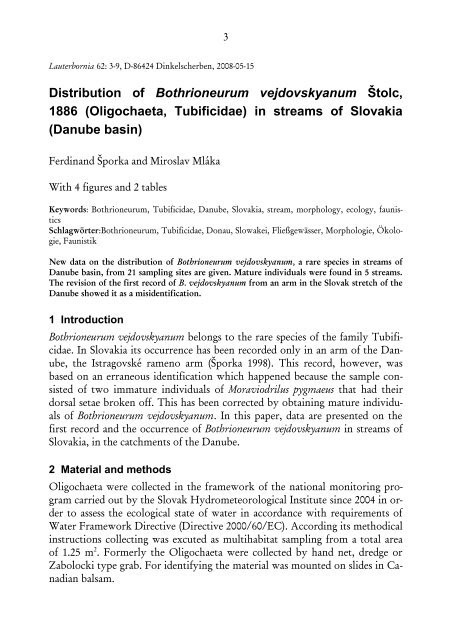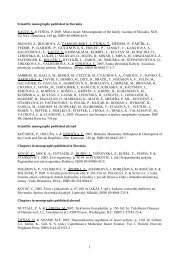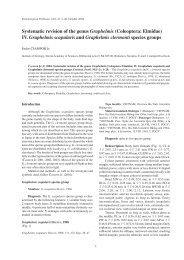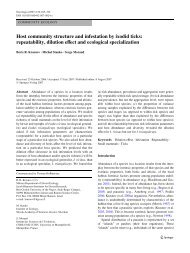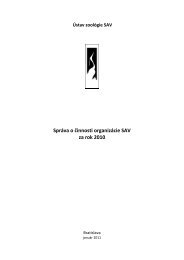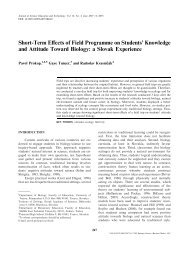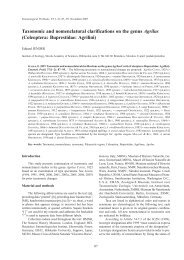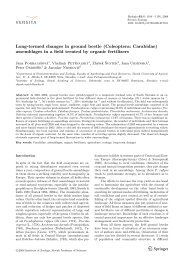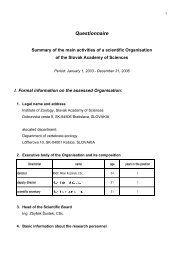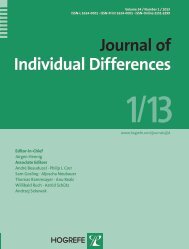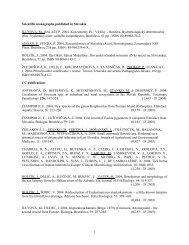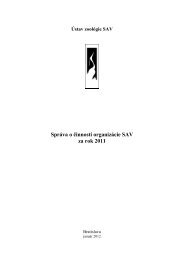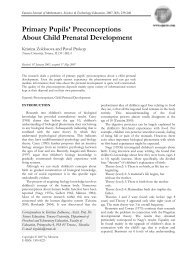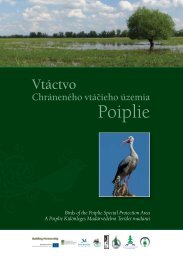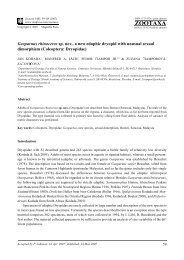(Oligochaeta, Tubificidae) in streams of Slovakia (Danube basin)
(Oligochaeta, Tubificidae) in streams of Slovakia (Danube basin)
(Oligochaeta, Tubificidae) in streams of Slovakia (Danube basin)
You also want an ePaper? Increase the reach of your titles
YUMPU automatically turns print PDFs into web optimized ePapers that Google loves.
3<br />
Lauterbornia 62: 3-9, D-86424 D<strong>in</strong>kelscherben, 2008-05-15<br />
Distribution <strong>of</strong> Bothrioneurum vejdovskyanum Štolc,<br />
1886 (<strong>Oligochaeta</strong>, <strong>Tubificidae</strong>) <strong>in</strong> <strong>streams</strong> <strong>of</strong> <strong>Slovakia</strong><br />
(<strong>Danube</strong> bas<strong>in</strong>)<br />
Ferd<strong>in</strong>and Šporka and Miroslav Mláka<br />
With 4 figures and 2 tables<br />
Keywords: Bothrioneurum, <strong>Tubificidae</strong>, <strong>Danube</strong>, <strong>Slovakia</strong>, stream, morphology, ecology, faunistics<br />
Schlagwörter:Bothrioneurum, <strong>Tubificidae</strong>, Donau, Slowakei, Fließgewässer, Morphologie, Ökologie,<br />
Faunistik<br />
New data on the distribution <strong>of</strong> Bothrioneurum vejdovskyanum, a rare species <strong>in</strong> <strong>streams</strong> <strong>of</strong><br />
<strong>Danube</strong> bas<strong>in</strong>, from 21 sampl<strong>in</strong>g sites are given. Mature <strong>in</strong>dividuals were found <strong>in</strong> 5 <strong>streams</strong>.<br />
The revision <strong>of</strong> the first record <strong>of</strong> B. vejdovskyanum from an arm <strong>in</strong> the Slovak stretch <strong>of</strong> the<br />
<strong>Danube</strong> showed it as a misidentification.<br />
1 Introduction<br />
Bothrioneurum vejdovskyanum belongs to the rare species <strong>of</strong> the family <strong>Tubificidae</strong>.<br />
In <strong>Slovakia</strong> its occurrence has been recorded only <strong>in</strong> an arm <strong>of</strong> the <strong>Danube</strong>,<br />
the Istragovské rameno arm (Šporka 1998). This record, however, was<br />
based on an erraneous identification which happened because the sample consisted<br />
<strong>of</strong> two immature <strong>in</strong>dividuals <strong>of</strong> Moraviodrilus pygmaeus that had their<br />
dorsal setae broken <strong>of</strong>f. This has been corrected by obta<strong>in</strong><strong>in</strong>g mature <strong>in</strong>dividuals<br />
<strong>of</strong> Bothrioneurum vejdovskyanum. In this paper, data are presented on the<br />
first record and the occurrence <strong>of</strong> Bothrioneurum vejdovskyanum <strong>in</strong> <strong>streams</strong> <strong>of</strong><br />
<strong>Slovakia</strong>, <strong>in</strong> the catchments <strong>of</strong> the <strong>Danube</strong>.<br />
2 Material and methods<br />
<strong>Oligochaeta</strong> were collected <strong>in</strong> the framework <strong>of</strong> the national monitor<strong>in</strong>g program<br />
carried out by the Slovak Hydrometeorological Institute s<strong>in</strong>ce 2004 <strong>in</strong> order<br />
to assess the ecological state <strong>of</strong> water <strong>in</strong> accordance with requirements <strong>of</strong><br />
Water Framework Directive (Directive 2000/60/EC). Accord<strong>in</strong>g its methodical<br />
<strong>in</strong>structions collect<strong>in</strong>g was excuted as multihabitat sampl<strong>in</strong>g from a total area<br />
<strong>of</strong> 1.25 m 2 . Formerly the <strong>Oligochaeta</strong> were collected by hand net, dredge or<br />
Zabolocki type grab. For identify<strong>in</strong>g the material was mounted on slides <strong>in</strong> Canadian<br />
balsam.
4<br />
Tab. 1: <strong>Oligochaeta</strong> at 21 sampl<strong>in</strong>g sites (description see table 2) <strong>in</strong> <strong>Slovakia</strong>. i = immature, m = mature specimens<br />
Taxon/Number <strong>of</strong> sampl<strong>in</strong>g site 1 2 3 4 5 6 7 8 9 10 11 12 13 14 15 16 17 18 19 20 21<br />
Bothrioneurum vejdovskyanum Štolc, 1888 i i i i m m i m m i m i i i m m i i i i i<br />
Dero digitata O. F. Müller, 1773 ●<br />
Nais bretscheri Michaelsen, 1899 ● ● ● ● ●<br />
Nais el<strong>in</strong>guis O. F. Müller, 1773 ● ● ● ● ● ● ● ●<br />
Ophidonais serpent<strong>in</strong>a (O. F. Müller, 1773) ●<br />
Stylaria lacustris (L<strong>in</strong>naeus, 1767) ● ● ●<br />
Aulodrilus japonicus Yamaguchi, 1953 ●<br />
Branchiura sowerbyi Beddard, 1892 ● ● ● ●<br />
Rhyacodrilus cocc<strong>in</strong>eus (Vejdovský, 1879) ● ● ● ● ● ● ● ● ● ●<br />
Limnodrilus h<strong>of</strong>fmeisteri Claparède, 1862 ● ● ● ● ● ● ● ● ● ● ● ● ● ● ● ● ●<br />
Limnodrilus claparedeianus Ratzel, 1868 ● ● ● ● ● ● ● ● ● ● ● ● ● ● ● ●<br />
Limnodrilus udekemianus Claparède, 1862 ● ● ● ● ● ● ● ●<br />
Potamothrix moldaviensis (Vejdovský & Mrázek, 1902) ● ● ● ●<br />
Potamothrix bavaricus (Oschmann, 1913) ● ●<br />
Potamothrix hammoniensis (Michaelsen, 1901) ● ● ● ● ●<br />
Psammoryctides albicola (Michaelsen, 1901) ● ●<br />
Psammoryctides barbatus (Grube, 1861) ● ● ● ● ●<br />
Spirosperma ferox Eisen, 1879 ●<br />
Tubifex tubifex (O. F. Müller, 1774) ● ● ● ● ● ● ● ● ● ● ● ●<br />
Stylodrilus her<strong>in</strong>gianus Claparède, 1862 ● ● ● ● ● ● ● ●<br />
Lumbriculus variegatus (O. F. Müller, 1774) ● ● ● ● ● ● ●<br />
Proppapus volki Michaelsen, 1916 ●<br />
Fridericia sp. ● ● ● ● ●<br />
Enchytraeidae gen.sp. ● ● ● ● ● ● ● ● ●<br />
Lumbricillus rivalis Lev<strong>in</strong>sen, 1883 ● ● ●<br />
Eiseniella tetraedra (Savigny, 1826) ● ● ● ● ● ● ●
5<br />
3 Results and discussion<br />
We have recorded Bothrioneurum vejdovskyanum at 21 sites <strong>in</strong> the catchments<br />
<strong>of</strong> the rivers Morava, Váh, Hron, Ipeľ, Slaná, Bodva, Laborec and Uh, tributaries<br />
<strong>of</strong> the <strong>Danube</strong> (Fig. 1, Tab. 2). In 5 localities the mature <strong>in</strong>dividuals were<br />
present <strong>in</strong> mid April, <strong>in</strong> early May, <strong>in</strong> the first half <strong>of</strong> June and <strong>in</strong> mid October<br />
(Tab. 1). The same period <strong>of</strong> occurrence <strong>of</strong> mature <strong>in</strong>dividuals is also given by<br />
other authors. As mentioned by Hrabě (1934), Černosvitov found mature <strong>in</strong>dividuals<br />
<strong>in</strong> mid June, Štolc by end <strong>of</strong> May and Schenková et al. (2006) <strong>in</strong> May<br />
and June.<br />
Fig. 1: Sampl<strong>in</strong>g sites <strong>of</strong> Bothrioneurum vejdovskyanum <strong>in</strong> <strong>Slovakia</strong>. Description see<br />
table 2<br />
Tab. 2: Description <strong>of</strong> sampl<strong>in</strong>g sites and date <strong>of</strong> sampl<strong>in</strong>g. Size <strong>of</strong> stream accord<strong>in</strong>g<br />
catchment size: small = 10-100 km 2 , medium = 100-1000 km 2 , large = above 1000 km 2<br />
1. River Morava - Moravský Svätý Ján, (N 48º 34’ 52”, E 16º 56’ 18”) alt. 150 a.s.l., catchment Morava, large river - date <strong>of</strong><br />
sampl<strong>in</strong>g 14.7.2004, 5.9.2006<br />
2. River Morava – Brodské, (N 48º 41’ 25”, E 16º 59’ 12”) alt.155 a.s.l., catchment Morava, large river - date <strong>of</strong> sampl<strong>in</strong>g<br />
12.10.2006<br />
3. River Malý Dunaj – Jelka, (N 48º 07’ 41”, E 17º 28’ 46”) alt. 120 a.s.l., catchment Váh, large river - date <strong>of</strong> sampl<strong>in</strong>g<br />
4.4.2005<br />
4. Irrigate channel Gabčíkovo -Topoľníky - Kútniky, (N 47º 58’ 13”, E 17º 40’ 24”), alt. 115 a.s.l., Váh, small stream - date <strong>of</strong><br />
sampl<strong>in</strong>g 13.10.2005<br />
5. River Hron - Kalná nad Hronom, (N 48º 12’ 22”, E 18º 31’ 08”), alt.160 a.s.l, catchment Hron, large river - date <strong>of</strong> sampl<strong>in</strong>g<br />
15.6.2005<br />
6. River Hron - Jur nad Hronom, (N 48º 07’ 46”, E 18º 36’ 34”), alt.145 a.s.l, catchment Hron, large river - date <strong>of</strong> sampl<strong>in</strong>g<br />
9.8.2000, 2.5.2001<br />
7. Side arm - Vozokany Horný meander, (N 48º 01’ 36”, E 18º 40’ 42”), alt.130 a.s.l, catchment Hron, large river - date <strong>of</strong><br />
sampl<strong>in</strong>g 16.10.2001<br />
8. River Hron - Kamenica, (N 47º 49’ 24”, E 18º 43’ 34”), alt.120 a.s.l, catchment Hron, large river - date <strong>of</strong> sampl<strong>in</strong>g<br />
9.5.2005
6<br />
9. River Ipeľ - Kalonda, (N 48º 14’ 15”, E 19º 36’ 01”), alt.165 a.s.l, catchment Ipeľ, large river - date <strong>of</strong> sampl<strong>in</strong>g 9.5.2005,<br />
10.10.2005, 2.5.2006, 2.10.2006<br />
10. River Krivánsky potok - pod Lučencom, (N 48º 19’ 11”, E 19º 41’ 12”), alt.180 a.s.l, catchment Ipeľ, medium river - date<br />
<strong>of</strong> sampl<strong>in</strong>g 20.6.2005<br />
11. River Rimava - Rimavské Janovce, (N 48º 20’ 33”, E 20º 03’ 16”), alt.190 a.s.l, catchment Slaná, medium river - date <strong>of</strong><br />
sampl<strong>in</strong>g 6.6.2005<br />
12. River Bodva - Hosťovce (Hidvegardo), (N 48º 33’ 47”, E 20º 50’ 58”), alt.180 a.s.l, catchment Bodva, medium river - date<br />
<strong>of</strong> sampl<strong>in</strong>g 11.4.2005<br />
13. River Hornád - Malá Lod<strong>in</strong>a, (N 48º 52’ 51”, E 21º 07’ 40”), alt.260 a.s.l, catchment Hornád, large river - date <strong>of</strong> sampl<strong>in</strong>g<br />
14.4.2005<br />
14. River Hornád - Ždaňa, (N 48º 36’ 40”, E 21º 20’ 16”), alt.175 a.s.l, catchment Hornád, large river - date <strong>of</strong> sampl<strong>in</strong>g<br />
12.4.2005<br />
15. River Laborec - Lastomír, (N 48º 42’ 41”, E 21º 55’ 19”), 105 a.s.l, catchment Laborec, large river - date <strong>of</strong> sampl<strong>in</strong>g<br />
3.5.2004, 19.4.2005<br />
16. Irrigate channel Zálužický kanál pod Šíravou, (N 48º 45’ 46”, E 21º 57’ 53”), alt.110 a.s.l, catchment Laborec, small<br />
stream - date <strong>of</strong> sampl<strong>in</strong>g 19.4.2005<br />
17. River Uh - P<strong>in</strong>kovce, (N 48º 36’ 41”, E 22º 10’ 20”), alt.105 a.s.l, catchment Laborec, large river - date <strong>of</strong> sampl<strong>in</strong>g<br />
27.4.2004, 13.4.2005<br />
18. River Uh - mouth, (N 48º 35’ 28”, E 21º 59’ 53”), alt.100 a.s.l, catchment Laborec, large river - date <strong>of</strong> sampl<strong>in</strong>g<br />
13.4.2005<br />
19. River Cirocha - mouth, (N 48º 56’ 25”, E 21º 57’ 07”), alt.155 a.s.l, catchment Laborec, medium river - date <strong>of</strong> sampl<strong>in</strong>g<br />
18.4.2005<br />
20. River Ondava - <strong>in</strong>flow to reservoir Domaša, (N 49º 07’ 56”, E 21º 38’ 16”), alt.160 a.s.l, catchment Bodrog, medium river<br />
- date <strong>of</strong> sampl<strong>in</strong>g 19.4.2005<br />
21. River Ondava - Nižný Hrušov, (N 48º 48’ 33”, E 21º 45’ 48”), alt.115 a.s.l, Bodrog, catchment Bodrog large river - date <strong>of</strong><br />
sampl<strong>in</strong>g 27.9.2006<br />
In the <strong>Danube</strong> bas<strong>in</strong>, B. vejdovskyanum has been recorded up to now <strong>in</strong> the<br />
Morava river bas<strong>in</strong> just <strong>in</strong> Czech republic territory (Svratka river near Vranovice;<br />
Dyje river near Dolní Věstonice, Morava river near Kromeříž) by Hrabě<br />
(1935). Recently its occurrence was confirmed by Schenková et al (2006) <strong>in</strong> the<br />
Rokytná river (the Dyja river bas<strong>in</strong>). In this locality it belonged to the abundant<br />
<strong>Oligochaeta</strong>, together with Bythonomus lemani. In <strong>Slovakia</strong> territory as<br />
mentioned <strong>in</strong> the <strong>in</strong>troduction, it has nor been recorded.<br />
B. vejdovskyanum shows an excellent regeneration ability, which is not<br />
known from other <strong>Tubificidae</strong> species (Hrabě 1934). Body regeneration is a<br />
prerequisite for asexual reproduction by architomical division. Therefore the<br />
sexual reproduction has just a menial significance. For this reason, mature <strong>in</strong>dividuals<br />
are rare and occur only dur<strong>in</strong>g a short period. As mentioned by Timm<br />
(1997), the mature <strong>in</strong>dividuals were not recorded <strong>in</strong> waters <strong>of</strong> Estonia and adjacent<br />
countries. This fact considerably complicates the identification.<br />
Accord<strong>in</strong>g to the description <strong>of</strong> Hrabě (1979), Bothrioneurum vejdovskyanum<br />
is characterized by the presence <strong>of</strong> coelomocytes <strong>in</strong> the coelom; accord<strong>in</strong>g<br />
to our observations, they are <strong>in</strong>dist<strong>in</strong>ct <strong>in</strong> fixed <strong>in</strong>dividuals. On the rounded<br />
protostomium, a dist<strong>in</strong>ct sensory pit is developped (Fig. 2). In the dorsal and<br />
ventral bundles it has only bifid crotchets, the upper tooth longer than the lower<br />
one anteriorly, teeth are equally long posteriorly, the hair setae <strong>in</strong> dorsal<br />
bundles are miss<strong>in</strong>g. The IX. or X. segment <strong>of</strong> the mature <strong>in</strong>dividuals bears 4-6<br />
penial setae with a bluntly hooked upper tooth, while the small lower tooth is<br />
split <strong>in</strong>to several denticles (Fig. 3). A spermatheca is miss<strong>in</strong>g, its function is<br />
overtaken by the external spermatophore, attached to the body wall and conta<strong>in</strong><strong>in</strong>g<br />
sperm (Fig. 4). Br<strong>in</strong>khurst & Jamieson (1971) suggest the term "sperm
7<br />
bearer", because the "spermatophore" should be reta<strong>in</strong>ed for the organized<br />
sperm bundles which characterize other species <strong>of</strong> <strong>Tubificidae</strong> (e.g. Tubifex sp.,<br />
Psammoryctides sp.).<br />
Fig. 2: Bothrioneurum vejdovskyanum. Anterior end <strong>of</strong> body, prostomium with sensory<br />
pit. a: after Hrabě (1981), b: scale 100 µm<br />
Fig. 3: Bothrioneurum vejdovskyanum. Penial setae <strong>in</strong> segment IX. a: after<br />
Cekanovskaya (1962), b: scale 50 µm
8<br />
Fig. 4: Bothrioneurum vejdovskyanum. Segment IX with sperm bearers (external spermatophores).<br />
a: after Cekanovskaya (1962), b: scale 100 µm<br />
Our observations show Bothrioneurum vejdovskyanum to be tolerant to eutrophication<br />
as well as to organic pollution. This conclusion is based on the simultaneous<br />
occurrence with pollution tolerant <strong>Oligochaeta</strong>, especially Limnodrilus species<br />
and Tubifex tubifex <strong>in</strong> waters with muddy substratum. L. h<strong>of</strong>fmeisteri (86 %),<br />
L. claparedeanus (71 %) and T. tubifex (57 %) co-occurred most frequently with B.<br />
vejdovskyanum. The frequency <strong>of</strong> other <strong>Oligochaeta</strong> species is given <strong>in</strong> table 1.<br />
Remarkable is the co-occurrence <strong>of</strong> B. vejdovskyanum with Branchiura sowerbyi,<br />
which prefers <strong>streams</strong> with warm water, <strong>in</strong> <strong>Slovakia</strong> especially downstream <strong>of</strong><br />
cool<strong>in</strong>g water outlets <strong>of</strong> power stations. Based on our f<strong>in</strong>d<strong>in</strong>g and characteristic<br />
<strong>of</strong> the localities studied, we conclude that B. vejdovskyanum is a species <strong>in</strong>habit<strong>in</strong>g<br />
the lowland <strong>streams</strong> or lower highland <strong>streams</strong>. Localities <strong>of</strong> its occurrence<br />
were situated at altitudes <strong>of</strong> 105-260 m. In a similar altitude (220 m) it was recorded<br />
by Schenková et al. (2006) <strong>in</strong> the Rokytná river. Here B. vejdovskyanum<br />
preferred shallow river stretches with less fluctuat<strong>in</strong>g water level and no shift<strong>in</strong>g<br />
substratum. Our observations also confirm these results. Co-occurrence <strong>of</strong><br />
the accompany<strong>in</strong>g species, especially <strong>of</strong> <strong>Tubificidae</strong>, also confirms its preference<br />
for muddy substrates.<br />
Accord<strong>in</strong>g to Timm (1997) the genus Bothrioneurum is <strong>in</strong>cluded <strong>in</strong>to the separate<br />
subfamily Bothrioner<strong>in</strong>ae (Hrabě, 1981), but other authors put it <strong>in</strong> the
9<br />
subfamily Rhyacodril<strong>in</strong>ae as its representatives have diffuse prostate tissue on<br />
the atria and abundant large coelomocytes. At present the genus Bothrioneurum<br />
<strong>in</strong>cludes 6 species: B. vejdovskyanum Štolc, 1886; B. americanum Beddard,<br />
1894; B. iris Beddard, 1901; B. pyrrhum Marcus, 1942; B. brauni Marcus, 1949<br />
and B. schiemeri Timm, 1997. As given by Timm (1997), the genus Bothrioneurum<br />
is one <strong>of</strong> few <strong>Oligochaeta</strong> genera, whose representatives are adopted to<br />
warm tropical waters. Among them, only Bothrioneurum vejdovskyanum is<br />
widely distributed <strong>in</strong> the Holarctis.<br />
References<br />
Br<strong>in</strong>khurst, R. O. & B. G. M. Jamieson (1971): Aquatic <strong>Oligochaeta</strong> <strong>of</strong> the world.- 860 p., (Oliver<br />
& Boyd) Ed<strong>in</strong>burg<br />
Cekanovskaya, O. V. (1962): Vodnye malostet<strong>in</strong>kovye cervi fauny SSSR.- Opredeliteli po faune<br />
SSSR, 78, Izdatelstvo Akademii Nauk SSSR, 409 pp., Moskva<br />
European Commission (2000) Directive 2000/60/EC <strong>of</strong> the European Parliament and <strong>of</strong> the Council<br />
– Establish<strong>in</strong>g a framework for Community action <strong>in</strong> the field <strong>of</strong> water policy. Brussels, Belgium,<br />
23 October 2000<br />
Hrabě, S. (1934): O nepohlavním rozmnožování nítěnky Bothrioneurum vejdovskýanum Štolz.<br />
[Über die ungeschlechtliche Vermehrung des Bothrioneurum vejdovskýanum Štloc].- Sborník<br />
Klubu Přírodovědného 17: 13-18, Brno<br />
Hrabě, S. (1935): Űber Moraviodrilus pygmaeus n. g. n. sp., Rhyacodrilus falciformis Br., Ilyodrilus<br />
bavaricus Oschm. und Bothrioneurum vejdovskyanum St.- Spisy vydávané Přírodovědeckou<br />
fakultou Masarykovy University, Brno, 209: 1-19, Brno<br />
Hrabě, S. (1981). Vodní máloštět<strong>in</strong>atci (<strong>Oligochaeta</strong>) Československa.- Acta Universitatis Carol<strong>in</strong>ae,<br />
Biologica 1-2, 1979: 167 pp., Praha<br />
Schenková, J., J. Helešic & J. Jarkovský (2006): Seasonal dynamics <strong>of</strong> Bythonomus lemani and<br />
Bothrioneurum vejdovskyanum (<strong>Oligochaeta</strong>, Annelida) <strong>in</strong> relation to environmental variables.-<br />
Biologia 61: 517-523, Bratislava<br />
Šporka, F. (1998): The typology <strong>of</strong> floodpla<strong>in</strong> water bodies <strong>of</strong> the Middle <strong>Danube</strong> (<strong>Slovakia</strong>) on the<br />
basis <strong>of</strong> the superficial polychaete and oligochaete fauna.- Hydrobiologia 386: 55-62, Dordrecht<br />
Timm, T. (1997): A new species <strong>of</strong> Bothrioneurum Štolz, 1886 (<strong>Oligochaeta</strong>: <strong>Tubificidae</strong>) from<br />
Uganda.- Mitteilungen aus dem Hamburgischen Zoologischen Museum und Institut 94: 27-33,<br />
Hamburg<br />
Address <strong>of</strong> the authors:<br />
Dr. Ferd<strong>in</strong>and Šporka, Department Hydrobiology, Institute <strong>of</strong> Zoology Slovak Academy <strong>of</strong> Sciences,<br />
Dúbravská cesta 9, SK-84506 Bratislava, <strong>Slovakia</strong>; email: ferd<strong>in</strong>and.sporka@savba.sk<br />
Ing. Miroslav Mláka The Slovak Water Management Enterprise, state enterprise Branch Banska<br />
Bystrica, Sladkovicova 31, Banska Bystrica, 974 01, <strong>Slovakia</strong>; email: miroslav.mlaka@svp.sk<br />
Received: 2008-01-24


